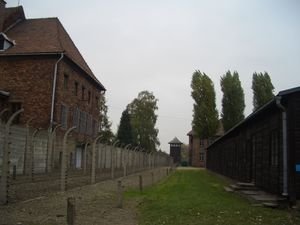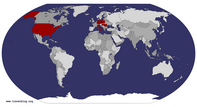Advertisement
Published: October 29th 2007

 Fence
Fence
This is a barabed wire fence at Auschwitz. That is a guard tower at the end. Last Monday morning I went to Auschwitz. The program had arranged for an English-speaking guide to lead our tour.
Driving up to Auschwitz was not exactly what I had expected. Thinking back on what I was expecting is kind of embarrassingly naïve. I guess I thought I would see a bunch of crematorium smoke stacks and beyond that I just pictured…hell.
Auschwitz is actually one of three concentration camps located close together, Auschwitz 2 is also known as Auschwitz-Birkenau, the third camp is Auschwitz 3 or Monowitz. Our tour began at Auschwitz and ended at Birkenau. Monowitz was not included.
Auschwitz was originally a polish military camp; this is when the large brick buildings were actually built. When the Nazis took it over they turned it into a prisoners camp where they held Polish prisoners. These were originally people they thought might be problems later on. This included all the Polish intellectuals and their families. Auschwitz the concentration camp began as a prison, not a death camp. The Nazis used it as propaganda to convince people of their lies. The camp was made up of nice large brick buildings, and they had the prisoners plant trees, they brought in bands to

 Shooting wall
Shooting wall
This is where they lined up the prisoners to shoot them. Two to a bullet, four at a time. play to welcome important visitors. Above the entrance is a sign that says in German, “Work makes Freedom”. Inside these buildings they crammed the prisoners into three tier bunk beds, sometimes with as many as four people a bunk.
Walking around the grounds now it’s hard to imagine the horrors you know took place there. You are reminded by different things such as the gallows in the middle of a square, or when you turn a corner and come face to face with the barbed wire fence and the guard towers. When the guide began to explain things it became increasingly difficult to look around and just see brick buildings and trees. We began to see the people who planted those trees. The prisoners all lined up being counted, in the snow. Or watching someone who was caught trying to escape getting hanged on the gallows, conveniently located right in front of where they had to line up.
Between blocks 10 and 11 was the shooting wall. This is where they shot people who had been convicted of a crime. No one was killed at Auschwitz without a reason. It was not murder; they had committed a crime, been tried

 The grounds
The grounds
This is Auschwitz. and sentenced to death. Or they died of natural causes (such as starvation or freezing to death). The prisoners were shot in twos to save bullets. Their trials lasted on average less than two minutes.
Inside block 11 we walked by the different holding cells they used. In order to prevent escape attempts they had a policy that if someone escaped, ten people who lived near them were punished in their place. This was to encourage the prisoners to tell on each other. Some of the methods of punishment involved special cells located in block 11. One method was to put four people into a cell the size of a phone booth to sleep. Every night. Not only could they not move or lie down, but if one of them passed out it was not uncommon for them to compress the other prisoners in such a way that they could no longer breath, killing all of them. After a night in one of these cells they still had to go out and work. This was to show the rest of the prisoners what would happen if they didn’t prevent other people from trying to escape. Another method was starvation. Ten

 Dusk
Dusk
Dusk at Birkenau. people placed in a cell and not given any food. After two weeks anyone still alive was killed by injecting poison into their heart.
The basement of block 11 was also the location of one of the first experiments with cyclone b, the gas used in the showers. They locked 850 people into the basement, sealed the doors and windows and tossed in some cyclone b. Because they were unsure how it would work they used too little. It took two full days for the people in the basement to die.
People were an expendable resource and thus it did not matter how they were treated. Once they expanded the source of prisoners beyond just the Polish, they began using them till they were no longer useful, killing them and getting more. As a result the average lifespan was less than 6 months.
One thing I never realized was that according to the Nazi records the vast majority of Jewish people who we now considered to have died at Auschwitz never actually were AT Auschwitz. This is because they only logged in the people who lived at the camp. People who were killed upon arrival were never actually THERE. This

 Train Tracks
Train Tracks
These are the train tracks leading into Birkenau. You can see the gravel pit up ahead. There are flowers on the tracks.is why there are no records.
Auschwitz was the only concentration camp that actually tattooed numbers onto the prisoners. Prisoners from other camps with tattoos started out at Auschwitz and were later moved.
After block 11 we went to another building that was titled “Material Evidence of Crime”. Within this building are the displays of things found around Auschwitz. This was unbelievably difficult. The Nazis did not waste anything and thus they kept everything. When Auschwitz was discovered they found seven tons of human hair. This hair was to be used to stuff coats, pillows and blankets. Or to be woven into cloth. On display was a roll of fabric made entirely out of human hair. You could see the hair sticking out from the side of the roll. There was a room displaying two tons of human hair. Another room was full of suitcases, another pots and pans, another prosthetic limbs. There was the room of shoes as well. You spend the entire tour trying to visualize it, then trying to block it out, and then you see the tiny pair of white baby shoes at the front of the pile and your emotions are no longer yours.
All

 Gateway
Gateway
This is the entryway into Birkenau. This is looking out of the camp. the pictures of families getting off the trains in Auschwitz and basically everyone of those babies was taken to a shower and never came out.
A common misconception about the showers is that the gas came out of the showerheads. In actuality the gas was in a liquid form soaked into pills, these were dropped through a hole in the ceiling, releasing the gas once the pressure decreased, killing all the people. These showers did have showerheads. They were not connected to any water source. It was one of the methods used to try and keep the people under control up to their last breath. When the women and children, and the men who were unfit for work, entered these buildings they were told to hang their clothing on numbers hooks on the wall. They were told to remember their hook number in order to help them find their clothing after the shower. They were told to tie their shoelaces together so they wouldn’t get lost with other peoples shoes. Some were even handed bars of soap to take into the showers with them.
Auschwitz has one crematorium and shower. These were reconstructed as they had been destroyed at the

 barbed wire
barbed wire
looking through the fence at the buildings. you can see the footprints of some of the buildings that are no longer there. end of the war. While they had been used, they stopped using them once Birkenau was built as it had bigger and better facilities.
Birkenau was never actually completed. It only reached about half the size it was intended to be. Located down the road from Auschwitz, Birkenau is more along the lines of what I expected. We arrived towards dusk, it was freezing cold and there was a light fog covering everything. The giant barbed wire fence stretched on and on beyond the giant front gate and the rows of barracks seems endless.
The railroad tracks lead right through the front gate and into the camp, stopping at an area covered in gravel, the sorting area. It was here at this gravel pit where people were sorted into fit for work, and unfit for work. Left or right. Cyclone B or water. Life or death. Right there on that stretch of gravel.
The barracks were mostly torn down after the war but some have been rebuilt for the museum. Other left only the footprint of the building.
We entered two of these, one was full of bunks, and the other was the room used for relieving ones self. This

 Smoke stack
Smoke stack
This is the smoke stack from the one crematorium at Auschwitz 1. room had a long row of holes over a large trench, but most people never made it that far, the number of people crammed in at the same time made it impossible. Some survivors have argued that cleaning out these trenches was the best possible job if you had the immune system for it. The building smelt so awful the guards never entered, so they could work at their own pace. They were actually working in buildings, so they had a roof over their heads. And during the winter, standing in the trench of human excrement one was able to stay somewhat warm.
The crematorium and showers at Birkenau were destroyed at the end of the war. You can walk out beyond the row of trees at the back to see the remains, but we did not.
If you want to read a horror story about Auschwitz look up Dr. Josef Mengele. I contemplated writing about him but I don’t think I am going to.
I am glad I made the trip to Auschwitz. There is a difference between reading about the horrors and walking amongst their ghosts. The holocaust will hold a different meaning for me now that I

 Block 11
Block 11
This is the entrance of Block 11have been to this death camp, and this is very important. This is the point.
Advertisement
Tot: 0.089s; Tpl: 0.013s; cc: 10; qc: 57; dbt: 0.0499s; 1; m:domysql w:travelblog (10.17.0.13); sld: 1;
; mem: 1.2mb












Aggie
non-member comment
Wow. I can only imagine how painful and emotionally draining it must have been to walk through the camps. Even just looking at your pictures gives me chills. You are brave. Love you lots, Aggie